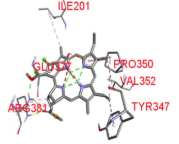In Silico Prediction of Anti-Inflammatory Potential of Isolated Compounds from Enhalus acoroides Tropical Journal of Natural Product Research
Main Article Content
Abstract
Enhalus acoroides is a marine flowering plant with numerous biological activities. The current study aim to isolate, characterize the chemical constituents from Enhalus acoroides whole plant, and to evaluate their anti-inflammatory activity in silico. The dried powdered E. acoroides whole plant was subjected to extraction, portioning, and chromatographic separation for the isolation of its phytochemical constituents. The structures of the isolated compounds were elucidated by a combination of Nuclear Magnetic Resonance (NMR) spectroscopy, Mas Spectrometry (MS), and comparison of spectral data with literature. The isolated compounds were investigated for their potential anti-inflammatory activity in silico via molecular docking of the compounds with inducible nitric oxide synthase (iNOS). Phytochemical investigation of the whole plant of E. acoroides led to the isolation of ten (10) compounds. Their chemical structures were determined as methyl pheophorbide a (1), (+)-catechin-4’-O-β-D-glucoside (2), quercetin (3), rutin (4), apigenin-7-O-α-L-rhamnopyranosyl-(1→2)-β-D-glucopyranoside (5), adenosine (6), uracil (7), D-mannitol (8), 6β-hydroxystigmast-4-en-3-one (9), and daucosterol(10) by ESI-MS, NMR spectral analysis, and comparison with published data. Molecular docking simulations of the compounds revealed their potential iNOS inhibitory activity, with compounds 1, 2, 3, 4, 5, 9, and 10 showing stronger binding affinities than the reference inhibitor, ethyl 4-[(4-methylpyridin-2-yl)amino]piperidine-1-carboxylate (AR-C95791). These findings suggest that the compounds, particularly compound 10, hold significant promise as iNOS inhibitors, potentially serving as candidates for anti-inflammatory drug development.
Downloads
Article Details

This work is licensed under a Creative Commons Attribution-NonCommercial-NoDerivatives 4.0 International License.
References
1. Kannan RRR, Arumugam R, Anantharaman P. In vitro antioxidant activities of ethanol extract from Enhalus acoroides (LF) Royle. Asian Pac J Trop Med. 2010; 3(11):898-901. DOI: 10.1016/S1995-7645(10)60216-7.
2. Qi SH, Zhang S, Qian PY, Wang BG. Antifeedant, antibacterial, and antilarval compounds from the South China Sea seagrass Enhalus acoroides. Bot Mar. 2008; 51(5):441-447. DOI: 10.1515/BOT.2008.054.
3. Wang XB, Sun ZH, Fan LX, Liu YY, Feng J, Ma GX, Chen DL. Two novel diterpenes from the stems and leaves of tropical seagrass Enhalus acoroides in the South China sea. Nat Prod Res. 2021; 35(9):1465-1473. DOI: 10.1080/14786419.2019.1655025.
4. Kannan RRR, Arumugam R, Anantharaman P. Chemical composition and antibacterial activity of Indian seagrasses against urinary tract pathogens. Food Chem. 2012; 135(4):2470-2473. DOI: 10.1016/j.foodchem.2012.07.070.
5. Wang X. Study on the chemical constituents of the tropical seagrass Enhalus acoroides. J Hainan Normal Univ (Nat Sci). 2018; 31:383-386.
6. Garcin ED, Arvai AS, Rosenfeld RJ, Kroeger MD, Crane BR, Andersson G, Getzoff ED. Anchored plasticity opens doors for selective inhibitor design in nitric oxide synthase. Nat Chem Biol. 2008; 4(11):700-707. DOI: 10.1038/nchembio.115.
7. Rappé AK, Casewit CJ, Colwell KS, Goddard IWA, Skiff WM. UFF. A full periodic table force field for molecular mechanics and molecular dynamics simulations. J Am Chem Soc. 1992; 114(25): 10024-10035. DOI: 10.1021/ja00051a040.
8. O'Boyle NM, Banck M, James CA, Morley C, Vandermeersch T, Hutchison GR. Open Babel: An open chemical toolbox. J Cheminform. 2011; 3:1-14. DOI: 10.1186/1758-2946-3-33.
9. Trott O and Olson AJ. AutoDock Vina: improving the speed and accuracy of docking with a new scoring function, efficient optimization, and multithreading. J Comput Chem. 2010; 31(2):455-461. DOI: 10.1002/jcc.21334.
10. Eberhardt J, Santos-Martins D, Tillack AF, Forli S. AutoDock Vina 1.2. 0: New docking methods, expanded force field, and python bindings. J Chem Inf Model. 2021; 61(8):3891-3898. DOI: 10.1021/acs.jcim.1c00203.
11. Trang HTT, Xuan HN, Hong LC, Nhung TT, Thi TGD, Thi DH, Thuy TP. In silico molecular docking, DFT, and toxicity studies of potential inhibitors derived from Millettia dielsiana against human inducible nitric oxide synthase. J Chem Res. 2024; 48(4):17475198241263837. DOI: 10.1177/17475198241263837.
12. Hieu TT, Thuy PT, Thuan VT, Ha NX, Van HN, Nguyen NH, Giang LD. Chemical composition and antimicrobial activity of essential oil obtained from the rhizomes of Kaempferia champasakensis: in vitro and molecular docking studies. J Essent Oil-Bear Plants. 2023; 26(4):958-969. DOI: 10.1080/0972060X.2023.2251512.
13. Zerbib M, Mazauric JP, Meudec E, Le Guernevé C, Lepak A, Nidetzky B, Saucier C. New flavanol O-glycosides in grape and wine. Food Chem. 2018; 266:441-448. DOI: 10.1016/j.foodchem.2018.06.019.
14. Mouffok S, Haba H, Lavaud C, Long C, Benkhaled M. Chemical constituents of Centaurea omphalotricha Coss. & Durieu ex Batt. & Trab. Rec Nat Prod. 2012; 6(3):292-295.
15. Dos Santos MG, Moreno FS, de Oliveira AL, Oliveira IC, Tribuiani N, Cogo JC, Oshima-Franco Y. New pharmacological insights of Galactia glaucescens. Nat Prod Res. 2019; 33(16):2389-2393. DOI: 10.1080/14786419.2018.1443086.
16. Ma L and Dolphin D. Nucleophilic reaction of 1, 8-diazabicyclo [5.4. 0] undec-7-ene and 1, 5-diazabicyclo [4.3. 0] non-5-ene with methyl pheophorbide a. Unexpected products. Tetrahedron. 1996; 52(3):849-860. DOI: 10.1016/0040-4020(95)00944-2.
17. Phan VK. Study of components flavonoids and megastigmane glucosides of Ficus callosa. Vietnam J Chem. 2011; 49(1):55-59.
18. Huang ZB, Wu Z, Chen FK, Zou LB. The protective effects of phenolic constituents from Gastrodia elata on the cytotoxicity induced by KCl and glutamate. Arch Pharm Res. 2006; 29:963-968. DOI: 10.1007/BF02969279.
19. Chun QIN, Xiu P, Wen AI, Zhi-Long ZH, Jia-Yun XIA, Shi-HaiXU, Yong-Hong LIU. Secondary Metabolites from Mangrove Sonneratia apetala Endophytic Fungus Neofusicoccum sp. SaBA3. Nat Prod Res Dev. 2014; 26(8):1212.
20. Lee EJ, Lee JY, Kim JS, Kang SS. Phytochemical studies on Lonicerae flos (1)-isolation of iridoid glycosides and other constituents. 2010; 16(1):32-38.
21. Ibrakaw AS, Boatwright JS, Lesch T, Cupido CN, Hussein AA. Triterpenes and other minor chemical constituents of Boophone haemanthoides FM Leight (Amaryllidaceae). S Afr J Bot. 2021; 136:35-39. DOI: 10.1016/j.sajb.2020.06.025.
22. Lee YG, Cho JY, Lee HJ, Lee YH, Lee SH, Han TH, Moon JH. Isolation and identification of a sterol and three glucosides from the peel of pear (Pyrus pyrifolia Nakai cv. Chuhwangbae). Korean J Food Sci Technol. 2013; 45(5):557-564. DOI: 10.9721/KJFST.2013.45.5.557


